Organotrialkoxysilane-Functionalized Prussian Blue Nanoparticles-Mediated Fluorescence Sensing of Arsenic(III)
Abstract
1. Introduction
2. Experimental Section
2.1. Materials
2.2. Synthesis of PBN, PBN@SiO2 and PBN@MSNP Mediated through EETMSi
2.2.1. EETMSi-Mediated Formation of PBN
2.2.2. EETMSi-Mediated Formation of Prussian Blue Nanoparticles Modified Silica (PBN@SiO2)
2.2.3. EETMSi-Mediated Formation of PBN@MSNPs
2.3. Materials Characterization
2.4. Fluorometric Method
3. Results and Discussion
3.1. Organotrialkoxysilane-Mediated Synthesis of PBN Analogs
3.1.1. PBN as a Homogeneous Suspension
3.1.2. PBN Confined in Mesoporous Silica (PBN@SiO2)
3.1.3. PBN-Doped Mesoporous Silica Nanoparticles (PBN@MSNP)
3.2. FTIR Analysis of PBN@SiO2
3.3. Fluorometric Study
3.3.1. Effect of the Addition of As(III) on the Fluorescent Intensity of Fluorescein
3.3.2. Interaction of Fluorophore with PBN
3.3.3. Effect of As(III)/PBN System over Flo Intensity
3.4. As(III) Decontamination from Aqueous Solution Using PBN@SiO2
3.5. HPLC Results on PBN@SiO2 Treated Arsenic(III)
3.6. XPS Analysis of PBN@SiO2
3.6.1. Fe(II) and Fe(III) Identification in PBN@SiO2
3.6.2. As(III)-PBN@SiO2 and As(V)-PBN@SiO2
3.7. Effect of pH on Arsenic Removal
3.8. Analysis of PBN@SiO2 Surface through SEM-EDX after As(III) Remediation
3.9. Recyclability and Proposed Mechanism
3.10. Mechanism of PBN Based Fluorescence Sensing of As(III)
3.11. Characterization of Recyclable PBN@SiO2
4. Conclusions
Author Contributions
Funding
Institutional Review Board Statement
Informed Consent Statement
Data Availability Statement
Acknowledgments
Conflicts of Interest
References
- NRC. Subcommittee to Update the 1999 Arsenic in Drinking Water Report, Committee on Toxicology; NRC: Washington, DC, USA, 2002.
- Nriagu, J.O.; Azcue, J. Arsenic in the Environment. Part I: Cycling and Characterization; John Wiley & Sons: New York, NY, USA, 1994; Volume 26. [Google Scholar]
- Roberts, L.C.; Hug, S.J.; Ruettimann, T.; Billah, M.; Khan, A.W.; Rahman, M.T. Arsenic Removal with Iron(II) and Iron(III) in Waters with High Silicate and Phosphate Concentrations. Environ. Sci. Technol. 2004, 38, 307–315. [Google Scholar] [CrossRef] [PubMed]
- Holm, T.R. Effects of CO32−/bicarbonate, Si, and PO43− on Arsenic sorption to HFO. J. Am. Water Work. Assoc. 2002, 94, 174–181. [Google Scholar] [CrossRef]
- Jain, C.; Ali, I. Arsenic: Occurrence, toxicity and speciation techniques. Water Res. 2000, 34, 4304–4312. [Google Scholar] [CrossRef]
- Edwards, M. Chemistry of arsenic removal during coagulation and Fe-Mn oxidation. J. Am. Water Work. Assoc. 1994, 86, 64–78. [Google Scholar] [CrossRef]
- Shih, M.-C. An overview of arsenic removal by pressure-driven membrane processes. Desalination 2005, 172, 85–97. [Google Scholar] [CrossRef]
- Pandey, P.C.; Pandey, A.K. Tetrahydrofuran hydroperoxide mediated synthesis of Prussian blue nanoparticles: A study of their electrocatalytic activity and intrinsic peroxidase-like behavior. Electrochim. Acta 2014, 125, 465–472. [Google Scholar] [CrossRef]
- Pandey, P.C.; Singh, S.; Sawant, S.N. Functional alkoxysilane mediated controlled synthesis of Prussian blue nanoparticles, enabling silica alginate bead development; nanomaterial for selective electrochemical sensing. Electrochim. Acta 2018, 287, 37–48. [Google Scholar] [CrossRef]
- Karyakin, A.A.; Karyakina, E.E.; Gorton, L. Amperometric biosensor for glutamate using Prussian blue-based “artificial pe-roxidase” as a transducer for hydrogen peroxide. Anal. Chem. 2000, 72, 1720–1723. [Google Scholar] [CrossRef] [PubMed]
- Robin, M.B. The Color and Electronic Configurations of Prussian Blue. Inorg. Chem. 1962, 1, 337–342. [Google Scholar] [CrossRef]
- Pintado, S.; Goberna-Ferron, S.; Escudero-Adan, E.C.; Galan-Mascaros, J.R. Fast and persistent electrocatalytic water oxidation by Co–Fe Prussian blue coordination polymers. J. Am. Chem. Soc. 2013, 135, 13270–13273. [Google Scholar] [CrossRef]
- Qiu, J.-D.; Peng, H.-Z.; Liang, R.-P.; Li, J.; Xia, X.-H. Synthesis, Characterization, and Immobilization of Prussian Blue-Modified Au Nanoparticles: Application to Electrocatalytic Reduction of H2O2. Langmuir 2007, 23, 2133–2137. [Google Scholar] [CrossRef] [PubMed]
- Karyakin, A.A.; Puganova, E.A.; Budashov, I.A.; Kurochkin, I.N.; Karyakina, E.E.; Levchenko, V.A.; Matveyenko, V.N.; Varfolomeyev, S.D. Prussian blue based nanoelectrode arrays for H2O2 detection. Anal. Chem. 2004, 76, 474–478. [Google Scholar] [CrossRef]
- Pandey, P.C.; Singh, S.; Walcarius, A. Palladium-Prussian blue nanoparticles; as homogeneous and heterogeneous electrocat-alysts. J. Electroanal. Chem. 2018, 823, 747–754. [Google Scholar] [CrossRef]
- Itaya, K.; Uchida, I.; Neff, V.D. Electrochemistry of polynuclear transition metal cyanides: Prussian blue and its analogues. Acc. Chem. Res. 1986, 19, 162–168. [Google Scholar] [CrossRef]
- Han, L.; Yu, X.-Y.; Lou, X.W. Formation of Prussian-Blue-Analog Nanocages via a Direct Etching Method and their Conversion into Ni-Co-Mixed Oxide for Enhanced Oxygen Evolution. Adv. Mater. 2016, 28, 4601–4605. [Google Scholar] [CrossRef] [PubMed]
- Pandey, P.C.; Pandey, A.K. Electrochemical sensing of dopamine and pyrogallol on mixed analogue of Prussian blue nano-particles modified electrodes—Role of transition metal on the electrocatalysis and peroxidasemimetic activity. Electrochim. Acta 2013, 109, 536–545. [Google Scholar] [CrossRef]
- Pandey, P.C.; Pandey, A.K. Novel synthesis of super peroxidase mimetic polycrystalline mixed metal hexacyanoferrates na-noparticles dispersion. Analyst 2013, 138, 2295–2301. [Google Scholar] [CrossRef] [PubMed]
- Pandey, P.C.; Pandey, A.K. Novel synthesis of Prussian blue nanoparticles and nanocomposite sol: Electro-analytical ap-plication in hydrogen peroxide sensing. Electrochim. Acta 2013, 87, 1–8. [Google Scholar] [CrossRef]
- Pandey, P.C.; Upadhyay, B.C. Studies on differential sensing of dopamine at the surface of chemically sensitized Ormosil-modified electrodes. Talanta 2005, 67, 997–1006. [Google Scholar] [CrossRef]
- Zhang, W.; Singh, P.; Paling, E.; Delides, S. Arsenic removal from contaminated water by natural iron ores. Miner. Eng. 2004, 17, 517–524. [Google Scholar] [CrossRef]
- Morita, K.; Kaneko, E. Spectrophotometric Determination of Trace Arsenic in Water Samples Using a Nanoparticle of Ethyl Violet with a Molybdate–Iodine Tetrachloride Complex as a Probe for Molybdoarsenate. Anal. Chem. 2006, 78, 7682–7688. [Google Scholar] [CrossRef] [PubMed]
- Yuan, B.; Qu, J.; Lin, Q. Fluorimetric Determination of Arsenite and Arsenate in Water Using Fluorescein and Iodine. Int. J. Environ. Anal. Chem. 2002, 82, 31–36. [Google Scholar] [CrossRef]
- Zhu, R.H.; Chen, L. Spectrofluorimetric determination of arsenic(III) in water samples. Asian J. Chem. 2011, 23, 5271–5274. [Google Scholar]
- Dutta, D.; Chatterjee, S.; Pillai, K.; Pujari, P.; Ganguly, B. Pore structure of silica gel: A comparative study through BET and PALS. Chem. Phys. 2005, 312, 319–324. [Google Scholar] [CrossRef]
- Antony, R.; Manickam, S.T.D.; Kollu, P.; Chandrasekar, P.V.; Karuppasamy, K.; Balakumar, S. Highly dispersed Cu(II), Co(II) and Ni(II) catalysts covalently immobilized on imine-modified silica for cyclohexane oxidation with hydrogen peroxide. RSC Adv. 2014, 4, 24820–24830. [Google Scholar] [CrossRef]
- Ayers, J.B.; Waggoner, W.H. Synthesis and properties of two series of heavy metal hexacyanoferrates. J. Inorg. Nucl. Chem. 1971, 33, 721–733. [Google Scholar] [CrossRef]
- Cros, A.; Saoudi, R.; Hollinger, G.; Hewett, C.; Lau, S. An X-ray photoemission spectroscopy investigation of oxides grown on AuxSi1−x layers. J. Appl. Phys. 1990, 67, 1826–1830. [Google Scholar] [CrossRef]
- Datta, M.; Datta, A. In situ FTIR and XPS studies of the hexacyanoferrate redox system. J. Phys. Chem. 1990, 94, 8203–8207. [Google Scholar] [CrossRef]
- Stec, W.J.; Morgan, W.E.; Albridge, R.G.; van Wazer, J.R. Measured binding energy shifts of “3p” and “3d” electrons in arsenic compounds. Inorg. Chem. 1972, 11, 219–225. [Google Scholar] [CrossRef]
- Fantauzzi, M.; Atzei, D.; Elsener, B.; Lattanzi, P.; Rossi, A. XPS and XAES analysis of copper, arsenic and sulfur chemical state in enargites. Surf. Interface Anal. 2006, 38, 922–930. [Google Scholar] [CrossRef]
- Ding, M.B.; de Jong, B.H.; Roosendaal, S.J.; Vredenberg, A.X. XPS studies on the155 electronic structure of bonding between solid and solutes: Adsorption of arsenate, chromate, phosphate, Pb2+, and Zn2+ ions on amorphous blackferric oxyhydroxide. Geochim. Cosmochim. Acta 2000, 64, 1209–1219. [Google Scholar] [CrossRef]
- Brundle, C.; Chuang, T.; Wandelt, K. Core and valence level photoemission studies of iron oxide surfaces and the oxidation of iron. Surf. Sci. 1977, 68, 459–468. [Google Scholar] [CrossRef]
- Júnior, J.A.A.; Baldo, J.B. The Behavior of Zeta Potential of Silica Suspensions. New J. Glas. Ceram. 2014, 4, 29–37. [Google Scholar] [CrossRef]
- Gupta, V.; Saini, V.; Jain, N. Adsorption of As(III) from aqueous solutions by iron oxide-coated sand. J. Colloid Interface Sci. 2005, 288, 55–60. [Google Scholar] [CrossRef]
- Zen, J.-M.; Chen, P.-Y.; Kumar, A.S. Flow Injection Analysis of an Ultratrace Amount of Arsenite Using a Prussian Blue-Modified Screen-Printed Electrode. Anal. Chem. 2003, 75, 6017–6022. [Google Scholar] [CrossRef] [PubMed]
- Zen, J.-M.; Kumar, A.S.; Chen, H.-W. Electrochemical behavior of stable cinder/Prussian blue analogue and its mediated nitrite oxidation. Electro-Anal. Int. J. Devoted Fundam. Pract. Asp. Electroanal. 2001, 13, 1171–1178. [Google Scholar]
- Farah, A.M.; Shooto, N.D.; Thema, F.T.; Modise, J.S.; Dikio, E.D. Fabrication of Prussian blue/multi-walled carbon nanotubes modified glassy carbon electrode for electrochemical detection of hydrogen peroxide. Int. J. Electrochem. Sci. 2012, 7, e13. [Google Scholar]
- Pandey, P.C.; Shukla, S.; Pandey, G.; Narayan, R.J. Organotrialkoxysilane-mediated controlled synthesis of noble metal nanoparticles and their impact on selective fluorescence enhancement and quenching. J. Vac. Sci. GY B Nanotechnol. Microelectron. Mater. Process. Meas. Phenom. 2020, 38, 052801. [Google Scholar]
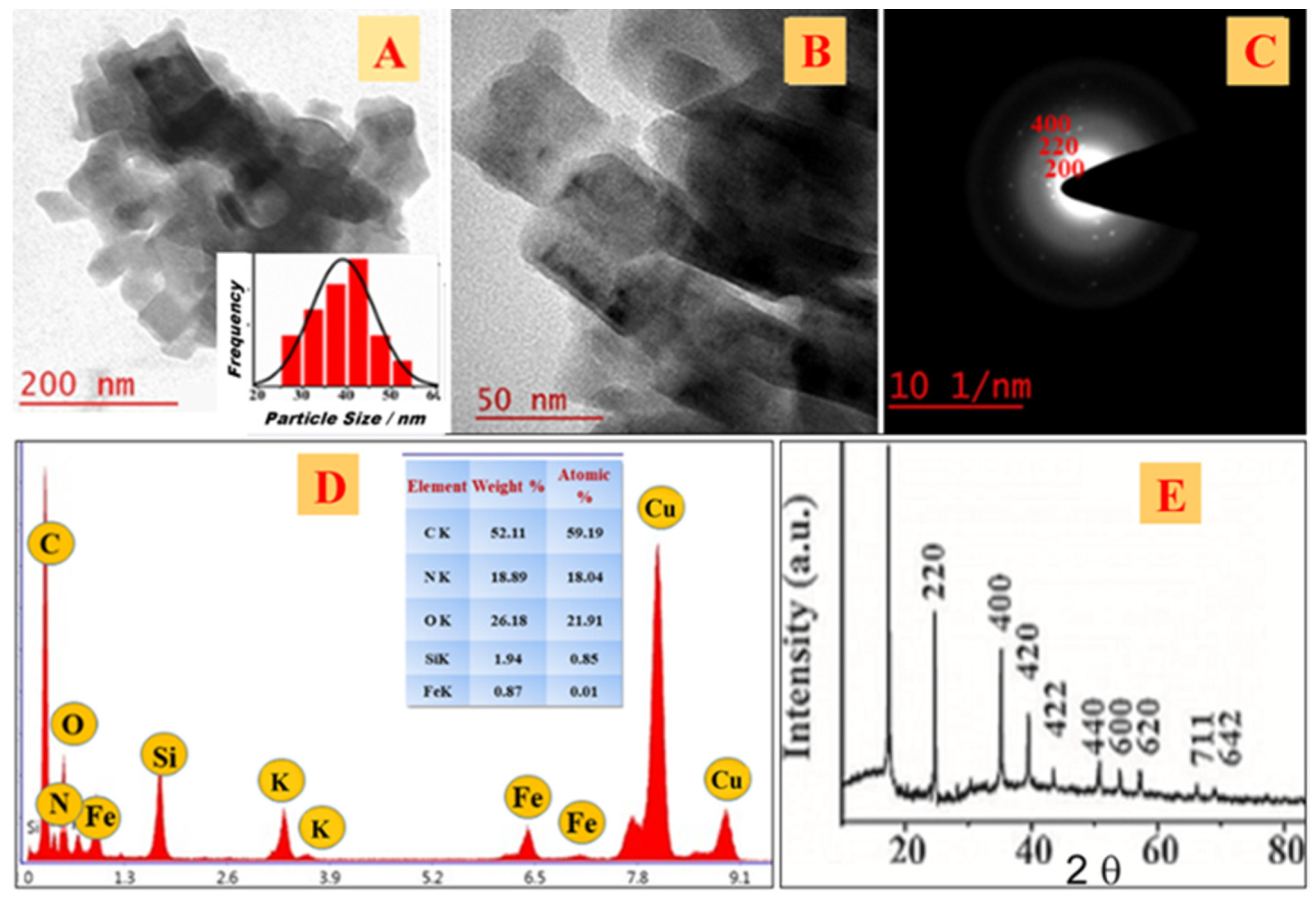
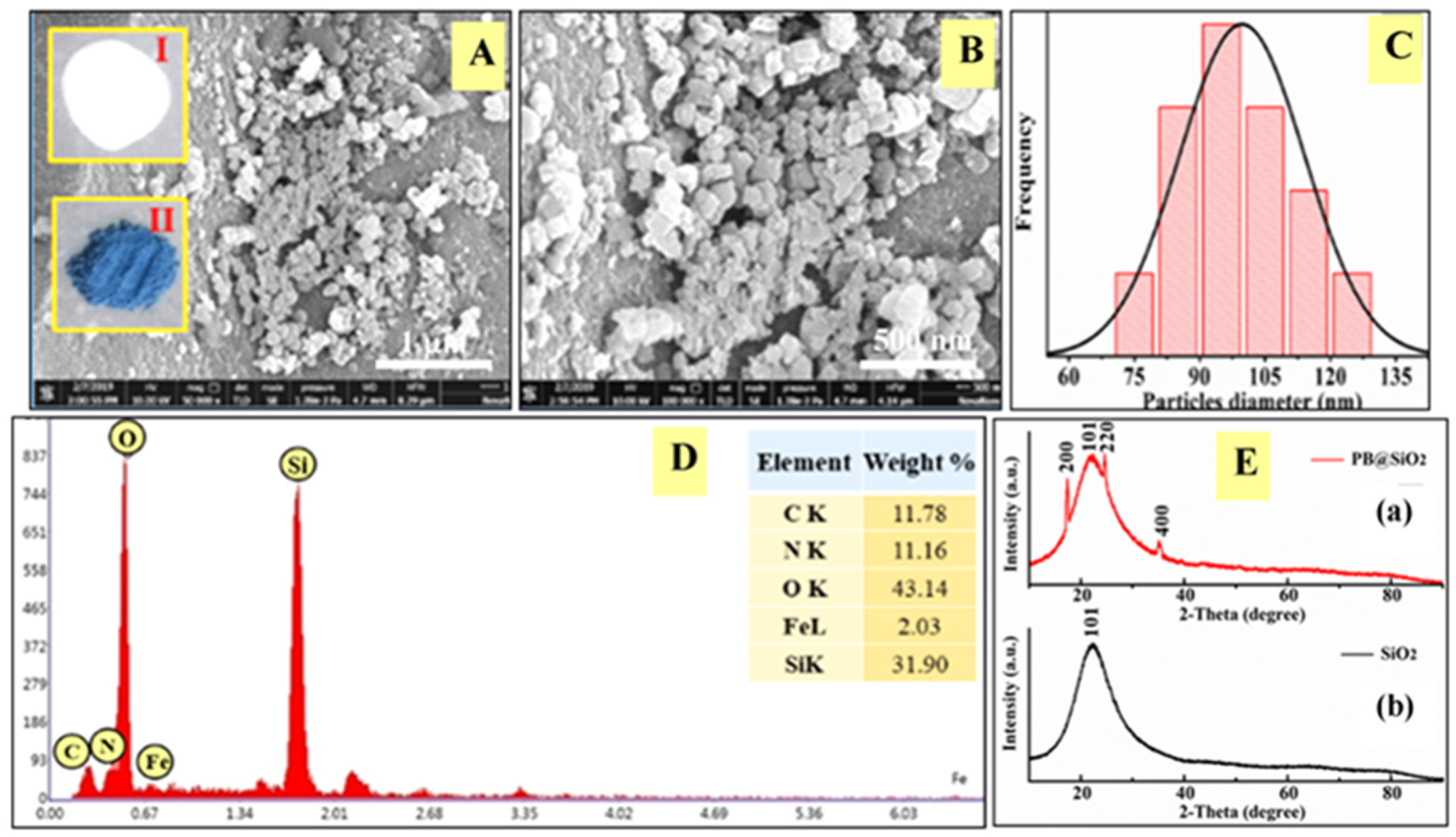
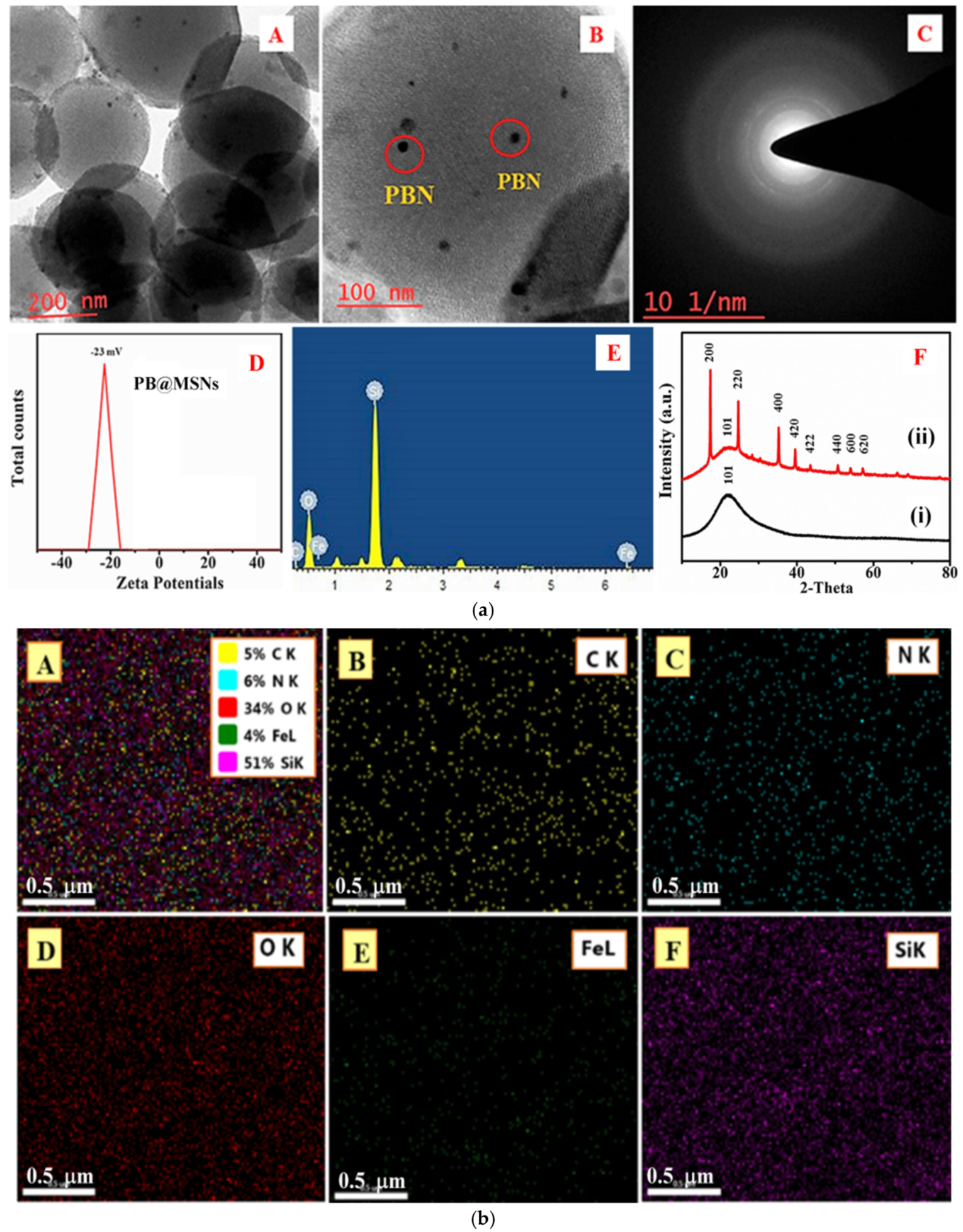
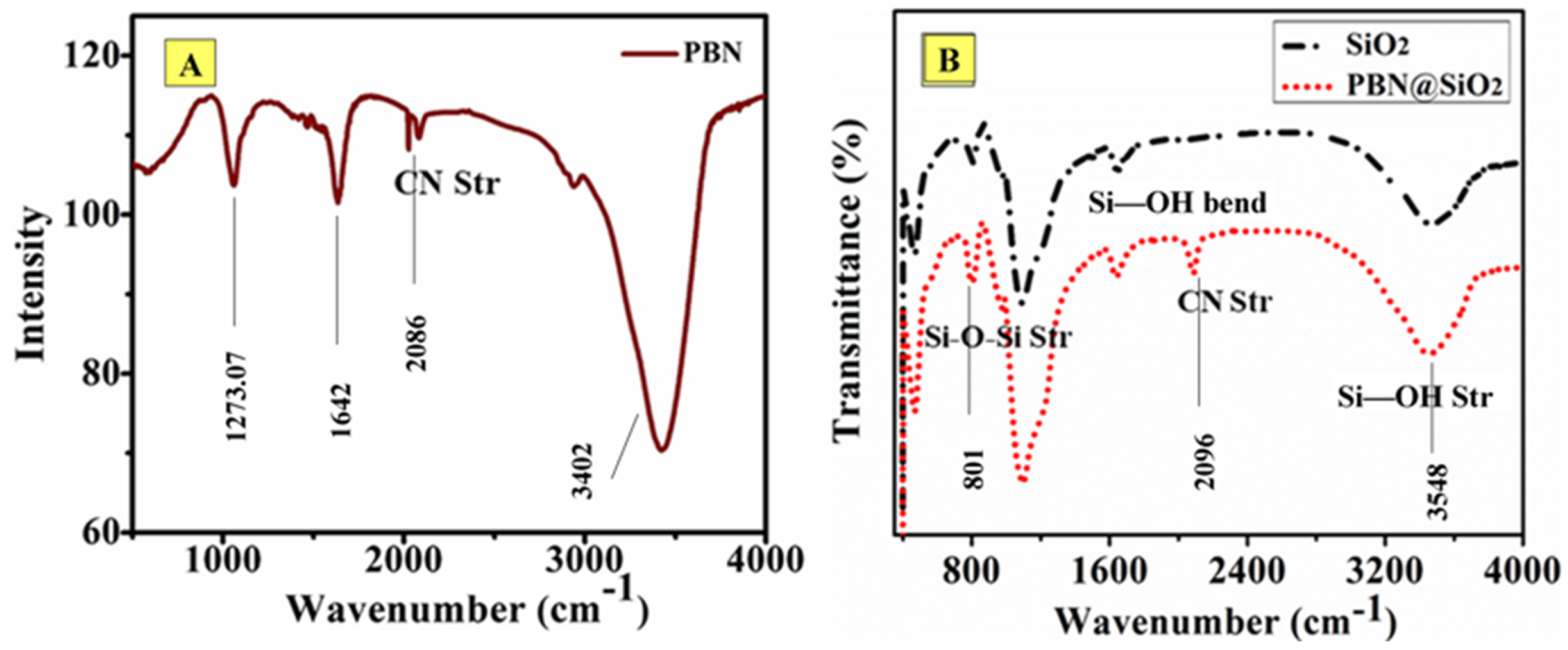

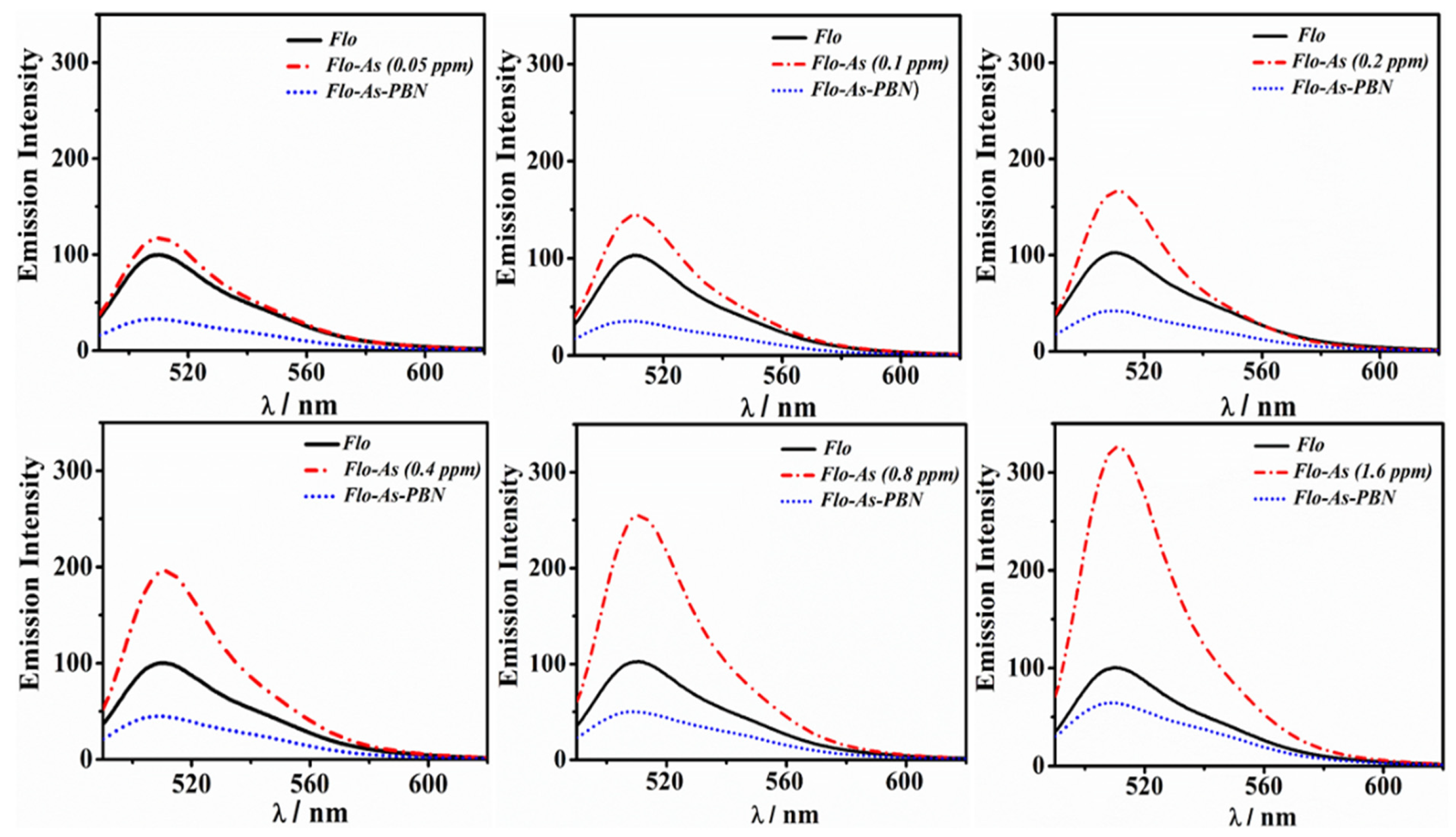

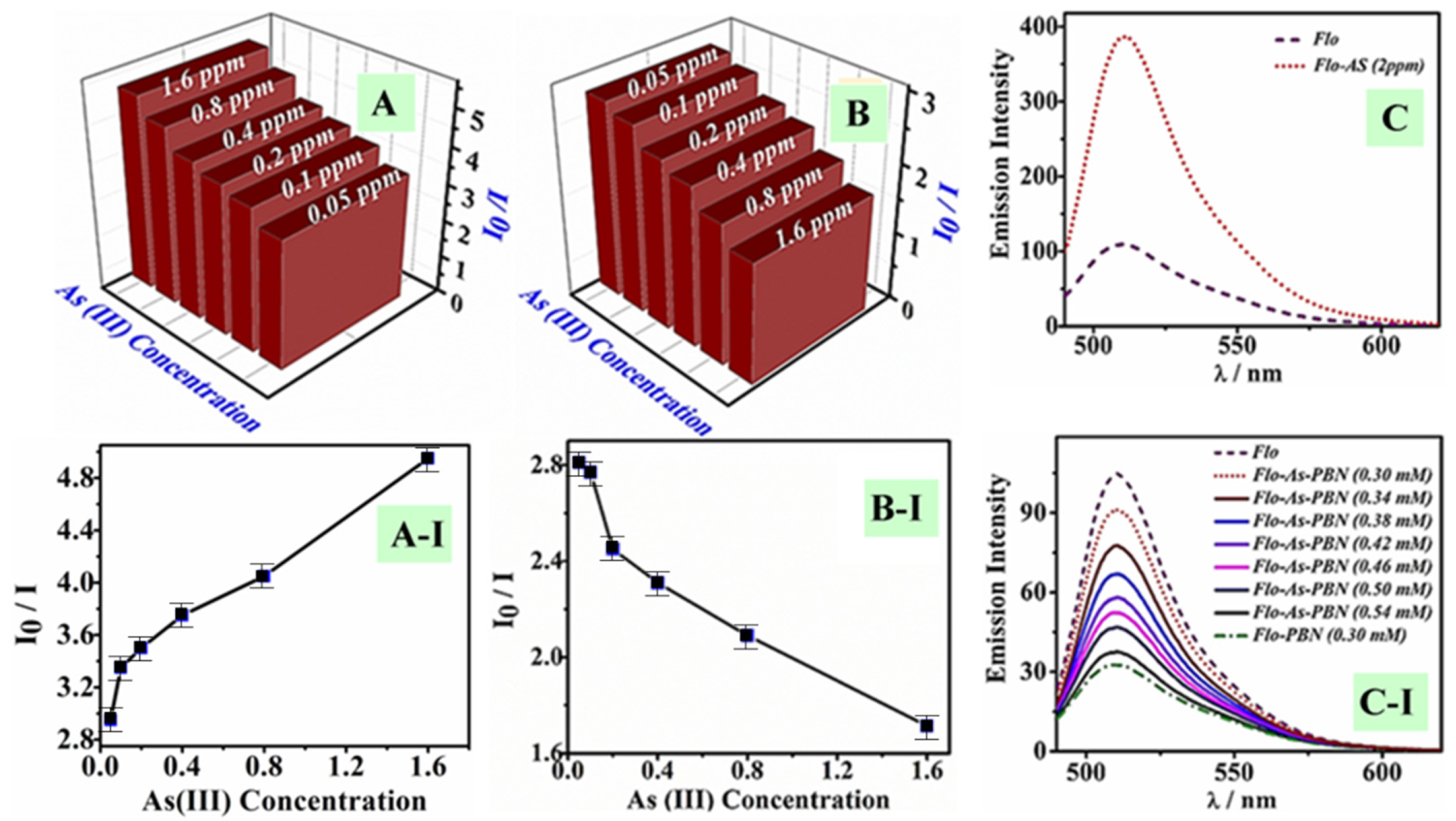


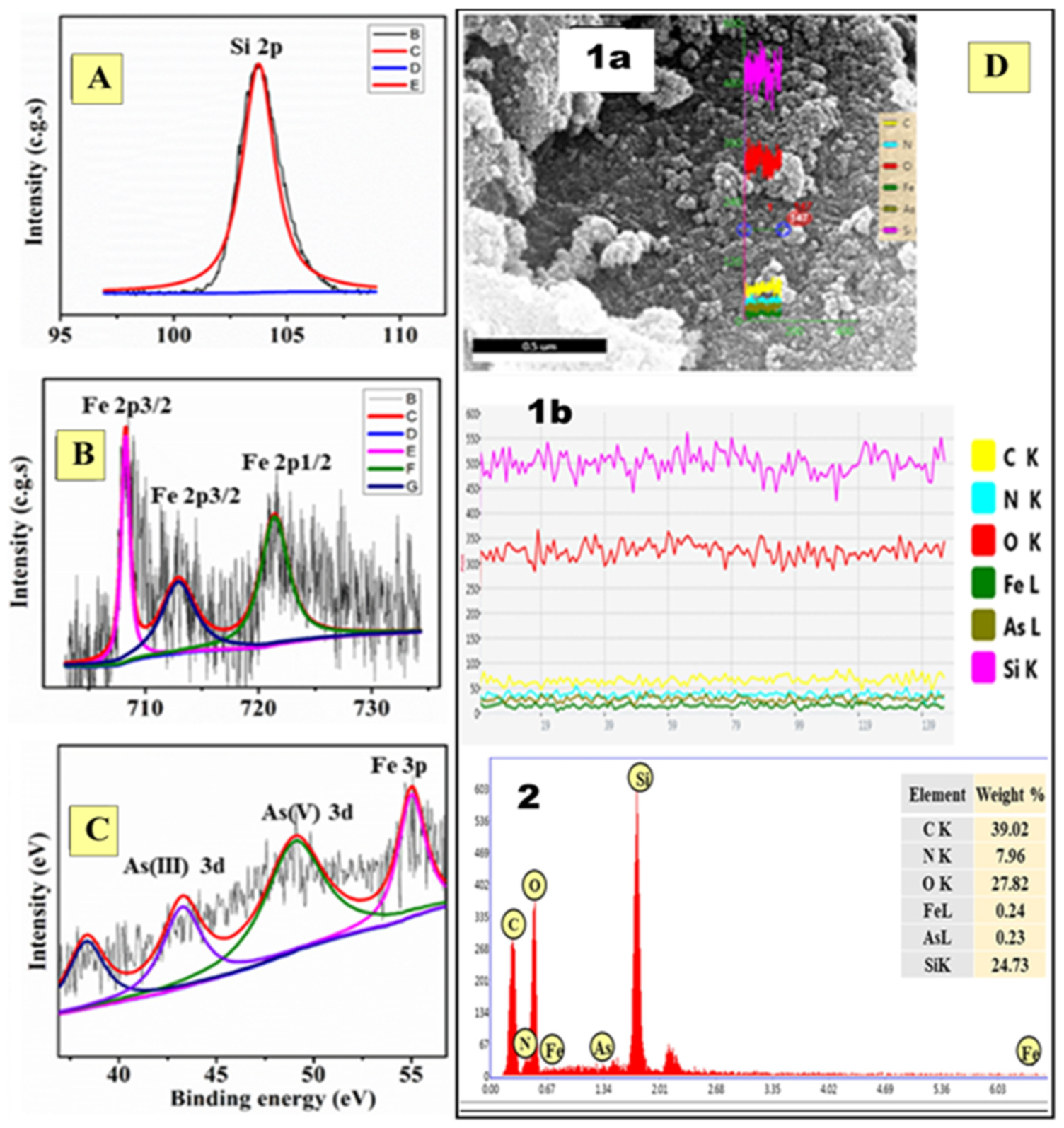

| Sample Name | Surface Area ×104 cm2/g | Pore Size (nm) |
|---|---|---|
| SiO2 Bead | 474.8 | 6.1 |
| PB@SiO2 Bead | 426.8 | 4.3 |
| Species | Description | Molecular Formula | Height (%) | Area (%) | System pH | Retention Time | Figure |
|---|---|---|---|---|---|---|---|
| AsIII | Sodium arsenite |  | 47.1 | 57.03 | 2.2 | 3.86 min | Figure 10B |
| (NaAsO2) | 23.86 | 30.65 | 6.8 | 3.97 min | Figure 10C | ||
| 6.91 | 5.23 | 8.5 | 3.95 min | Figure 10D | |||
| AsB | Arsenobetaine |  | 45.56 | 34.39 | 2.2 | 2.55 min | Figure 10B |
| (AsB) | 58.29 | 49.74 | 6.8 | 2.17 min | Figure 10C | ||
| 70.02 | 56.95 | 8.5 | 2.42 min | Figure 10D | |||
| DMA | Dimethylarsinic acid (DMA) |  | 6.85 | 4.21 | 2.2 | 3.58 min | Figure 10B |
| 15.81 | 16.21 | 6.8 | 3.57 min | Figure 10C | |||
| 13.45 | 11.79 | 8.5 | 3.57 min | Figure 10D |
| Sample | Si(2p) | O | Fe+3 | Fe+2 | Fe+2 | N | As(III) | As(V) |
|---|---|---|---|---|---|---|---|---|
| 1s | 2p3/2 | 2p1/2 | 2p3/2 | 1s | 3d | 3d | ||
| PBN@SiO2 | 103.63 | 532.62 | 712.12 | 721.27 | 708.34 | 397.07 | - | - |
| As-PBN@SiO2 | 103.49 | 531.99 | 712.86 | 721.42 | 708.19 | 397.05 and 398.99 | 43.23 | 49.03 |
| Analysis | Property | Unused PBN@SiO2 | Recycled PBN@SiO2 |
|---|---|---|---|
| HRSEM | Shape | Nanocubic (82%) | Nanocubic (19%) |
| and Spherical (18%) | and Spherical (81%) | ||
| HRSEM | Size | 70–20 nm | 17–26 nm |
| XRD | 2-Theta (Planes) | 17.6 (200), 24.3 (220), 37.83 (400) | 17.4 (200), 24.6 (220), 35.12 (400) |
| FTIR | CN Str. | 2096 cm−1 | 2054 cm−1 |
Publisher’s Note: MDPI stays neutral with regard to jurisdictional claims in published maps and institutional affiliations. |
© 2021 by the authors. Licensee MDPI, Basel, Switzerland. This article is an open access article distributed under the terms and conditions of the Creative Commons Attribution (CC BY) license (https://creativecommons.org/licenses/by/4.0/).
Share and Cite
Pandey, P.C.; Shukla, S.; Narayan, R.J. Organotrialkoxysilane-Functionalized Prussian Blue Nanoparticles-Mediated Fluorescence Sensing of Arsenic(III). Nanomaterials 2021, 11, 1145. https://doi.org/10.3390/nano11051145
Pandey PC, Shukla S, Narayan RJ. Organotrialkoxysilane-Functionalized Prussian Blue Nanoparticles-Mediated Fluorescence Sensing of Arsenic(III). Nanomaterials. 2021; 11(5):1145. https://doi.org/10.3390/nano11051145
Chicago/Turabian StylePandey, Prem. C., Shubhangi Shukla, and Roger J. Narayan. 2021. "Organotrialkoxysilane-Functionalized Prussian Blue Nanoparticles-Mediated Fluorescence Sensing of Arsenic(III)" Nanomaterials 11, no. 5: 1145. https://doi.org/10.3390/nano11051145
APA StylePandey, P. C., Shukla, S., & Narayan, R. J. (2021). Organotrialkoxysilane-Functionalized Prussian Blue Nanoparticles-Mediated Fluorescence Sensing of Arsenic(III). Nanomaterials, 11(5), 1145. https://doi.org/10.3390/nano11051145








